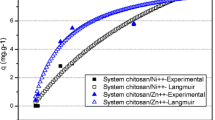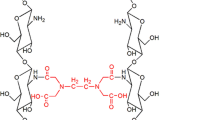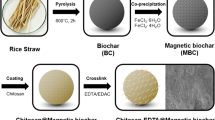Abstract
Affinity adsorption purification of hexahistidine-tagged (His-tagged) proteins using EDTA–chitosan-based adsorption was designed and carried out. Chitosan was elaborated with ethylenediaminetetraacetic acid (EDTA), and the resulting polymer was characterized by FTIR, TGA, and TEM. Different metals including Ni2+, Cu2+, and Zn2+ were immobilized with EDTA–chitosan, and their capability to the specific adsorption of His-tagged proteins were then investigated. The results showed that Ni2+–EDTA–chitosan and Zn2+–EDTA–chitosan had high affinity toward the His-tagged proteins, thus isolating them from protein mixture. The target fluorescent-labeled hexahistidine protein remained its fluorescent characteristic throughout the purification procedure when Zn2+–EDTA–chitosan was used as a sorbent, wherein the real-time monitor was performed to examine the immigration of fluorescent-labeled His-tagged protein. Comparatively, Zn2+–EDTA–chitosan showed more specific binding ability for the target protein, but with less binding capacity. It was further proved that this purification system could be recovered and reused at least for 5 times and could run on large scales. The presented M2+–EDTA–chitosan system, with the capability to specifically bind His-tagged proteins, make the purification of His-tagged proteins easy to handle, leaving out fussy preliminary treatment, and with the possibility of continuous processing and a reduction in operational cost in relation to the costs of conventional processes.











Similar content being viewed by others
References
Adriano WS, Mendonca DB, Rodrigues DS, Mammarella EJ, Giordano RLC (2008) Improving the properties of chitosan as support for the covalent multipoint immobilization of chymotrypsin. Biomacromolecules 9(8):2170–2179
Ali I (2012) New generation adsorbents for water treatment. Chem Rev 112:5073–5091
Arnau J, Lauritzen C, Petersen GE, Pedersen J (2006) Current strategies for the use of affinity tags and tag removal for the purification of recombinant proteins. J Protein Expres Purifi 48:1–13
Bailey SE, Olin TJ, Bricka RM, Adrian DD (1999) A review of potentially low-cost sorbents for heavy metals. Water Res 33(11):2469–2479
Chaga GS (2001) Twenty–five years of immobilized metal ion affinity chromatography: past, present and future. J Biochem Biophys Methods 49(1):313–334
Chaouk H, Hearn MTW (1999) Examination of the protein binding behaviour of immobilised copper (II)–2, 6–diaminomethylpyridine and its application in the immobilised metal ion affinity chromatographic separation of several human serum proteins. J Biochem Biophys Methods 39:161–177
Demolliens A, Boucher C, Durocher Y, Jolicoeur M, Buschmann MD, Decrescenzo G (2008) Tyrosinase–catalyzed synthesis of a universal coil–chitosan bioconjugate for protein immobilization. Bioconjugate Chem 19:1849–1854
Ghosh R (2002) Protein separation using membrane chromatography: opportunities and challenges. J Chromatogr A 952:13–27
Gutierrez R, Martín del Valle E, Galan M (2007) Immobilized metal ion affinity chromatography: status and trends. Sep Purif Rev 36(1):71–111
Groll J, Haubensak W, Ameringer T, Moeller M (2005) Ultrathin coatings from isocyanate terminated star PEG prepolymers: patterning of proteins on the layers. Langmuir 21:3076–3083
Jain P, Vyas MK, Geiger JH, Baker GL, Bruening ML (2010) Protein purification with polymeric affinity membranes containing functionalized poly (acid) brushes. Biomacromolecules 11:1019–1026
Lee JJ, Bruley DF, Kang KA (2007) Effect of pH and imidazole on protein C purification from Cohn fraction IV–1 by IMAC. Adv Eexp Med Biol 599:61–66
Janzen R, Unger K, Müller W, Hearn M (1990) Adsorption of proteins on porous and non–porous poly(ethyleneimine) and tentacle–type anion exchangers. J Chromatogr A 522:77–93
Khare AR, Peppas NA (1995) Swelling/deswelling of anionic copolymer gels. Biomaterials 16:559–567
Klein MP, Nunes MR, Rodrigues RC, Benvenutti EV, Costa TMH, Hertz PF, Ninow JL (2012) Effect of the support size on the properties of β-galactosidase immobilized on chitosan: advantages and disadvantages of macro and nanoparticles. Biomacromolecules 13:2456–2464
Kofuji K, Murata Y, Kawashima S (2005) Sustained insulin release with biodegradation of chitosan gel beads prepared by copper ions. Int J Pharm 303:95–103
Lan Q, Bassi AS, Zhu JX, Margaritis A (2001) A modified Langmuir model for the prediction of the effects of ionic strength on the equilibrium characteristics of protein adsorption onto ion exchange/affinity adsorbents. Chem Eng J 81(1–3):179–186
Li F, Du P, Chen W, Zhang SS (2007) Preparation of silica-supported porous sorbent for heavy metal ions removal in wastewater treatment by organic–inorganic hybridization combined with sucrose and polyethylene glycol imprinting. Anal Chim Acta 585:211–218
Montembault V, Soutif JC, Brosse JC (1996) Synthesis of chelating molecules as agents for magnetic resonance imaging, polycondensation of diethylenetriaminepentaacetic acid bisanhydride with diols and diamines. React Func Polym 29:29–39
Porath J, Carlsson J, Olsson I, Belfrage G (1975) Metal chelate affinity chromatography, a new approach to protein fractionation. Nature 258:598–599
Qiu M, Wu C, Ren GR, Liang XL, Wang XY, Huang JY (2014) Effect of chitosan and its derivatives as antifungal and preservative agents on postharvest green asparagus. Food Chem 155:105–11
Reddy DHK, Lee SM (2013) Synthesis and characterization of a chitosan ligand for the removal of copper from aqueous media. J Appl Polym Sci 130:4542–4550
Ren GW, Gong XW, Wang BL, Chen YY, Huang JY (2015) Affinity ionic liquids for the rapid liquid–liquid extraction purification of hexahistidine tagged proteins. Sep Purif Technol 146:114–120
Repo E, Warchol JK, Kurniawan TA, Sillanpaa MET (2010) Adsorption of Co(II) and Ni(II) by EDTA– and/or DTPA–modified chitosan: kinetic and equilibrium modeling. Chem Eng J 161:73–82
Roosen J, Binnemans K (2014) Adsorption and chromatographic separation of rare earths with EDTA and DTPA–functionalized chitosan biopolymers. J Mater Chem A 2:1530–1540
Shi XW, Wu HC, Liu Y, Tsao CY, Wang K, Kobatake E, Bentley WE, Payne GF (2008) Chitosan fibers: versatile platform for nickel–mediated protein assembly. Biomacromolecules 9:1417–1423
Stigter D, Dill A (1990) Charge effects on folded and unfolded proteins. Biochemistry 29:1262–1271
Tikhonov VE, Radigina LA, Yamskov YA (1996) Metal–chelating chitin derivatives via reaction of chitosan with nitrilotriacetic acid. Carbohyd Res 290:33–41
Tirtom VN, Dinçer A, Becerik S, Aydemir T, Çelik A (2012) Comparative adsorption of Ni(II) and Cd(II) ions on epichlorohydrin crosslinked chitosan–clay composite beads in aqueous solution. Chem Eng J 197:379–386
Ueda EKM, Gout PW, Morganti L (2003) Current and prospective applications of metal ion–protein binding. J Chromatogr A 988:1–23
Wang J, Zheng S, Shao Y, Liu J, Xu Z, Zhu D (2010) Aminofunctionalized Fe3O4@SiO2 core−shell magnetic nanomaterial as a novel adsorbent for aqueous heavy metals removal. J Colloid Interface Sci 349:293–299
Xu WY, Cao HZ, Ren GW, Xie HJ, Huang JY, Li SJ (2014) An AIL/IL–based liquid/liquid extraction system for the purification of his–tagged proteins. Appl Microbiol Biot 98:5665–5675
Yuan WY, Dong H, Li CM, Cui XQ, Yu L, Lu ZS, Zhou Q (2007) pH–controlled construction of chitosan/alginate multilayer film: characterization and application for antibody immobilization. Langmuir 23:13046–13052
Zachariou M, Hearn MT (1996) Application of immobilized metal ion chelate complexes as pseudocation exchange adsorbents for protein separation. Biochemistry 35(1):202–211
Zhang WC, Sun CY, Zhao Y, Lu XM (2011) One–pot synthesis and characterization of cross–linked quaternized chitosan microspheres as protein adsorbent. Int J Biol Macromol 49:688–692
Zhao FP, Sillanpa EPM, Meng Y, Yin DL, Tang WZ (2015) Green synthesis of magnetic EDTA–and/or DTPA–Cross–Linked chitosan adsorbents for highly efficient removal of metals. Ind Eng Chem Res 54:1271–1281
Zou H, Luo Q, Zhou D (2001) Affinity membrane chromatography for the analysis and purification of proteins. J Biochem Bioph Meth 49:199–240
Funding
This study was funded by the Natural Science Foundation of Zhejiang Province of China (Y3110204), the Technology Planning Project of Zhejiang Province of China (2011C12031), the National Science Foundation of China (21102129), and the Natural Key Technology R & D Program of China during the 12th Five-Year Plan Period (2012BAD29B06).
Ethical statement
This article does not contain any studies with human participants or animals performed by any of the authors.
Conflict of interest
The authors declare that they have no competing interests.
Author information
Authors and Affiliations
Corresponding author
Electronic supplementary material
Below is the link to the electronic supplementary material.
ESM 1
(PDF 183 kb)
Rights and permissions
About this article
Cite this article
Hua, W., Lou, Y., Xu, W. et al. Batch affinity adsorption of His-tagged proteins with EDTA-based chitosan. Appl Microbiol Biotechnol 100, 879–891 (2016). https://doi.org/10.1007/s00253-015-7137-5
Received:
Revised:
Accepted:
Published:
Issue Date:
DOI: https://doi.org/10.1007/s00253-015-7137-5




